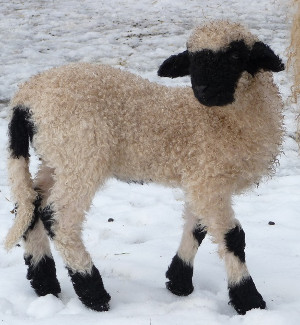Walliser Schwarznasenschaf (CH)
Description
A medium to large-framed mountain breed on short booted legs with short head. Sheep are unicoloured white apart from the desired spots. The nose is black up to the middle of the head, ears are black, too. The fleece consists of long coarse wool, the tail is woolly. Valais Blacknose are non-seasonal and mature late with age at first lambing of 14 months.
General and History
The breed that was first mentioned in 1884 has its origin in the Vispertal. There are, however, traces that black-noses sheep have existed since the 15th century. The breed was crossbred with Cotswold and Bergamasca in the 19th century and Southdown probably in the 20th century. Herdbook foundation 1950
Distribution in the past and today
The breed makes up for approx. 17% of the whole herdboock population and is particularly bred in Upper Valais. Centre of breeding is the valley of the Visp with its side valleys.
Utilization
Use of meat and wool and for pasture management.
Keeping
This breed is fast-growing, resistant, frugal and very well adapted to the rough mountain conditions. It is very well suited for the use of high-altitude pastures because of its loyalty to its location, climbing ability and frugality as regards feed. During summer, the animals stay on Alpine pastures, approx 10% graze pastures in the valleys. Winter housing lasts for 4 months.
Breeding aims
Opposition strength, health, freely from herditary defects, good adaptability, logevity with high motivation average production duration: 5 Years. Ability of high roughage admission and roughage utillisation. Retention of the excellent mountain, marketability, robustness, correct colour signs with female ans male animals.
Performance
Body weight: 80-130kg (m), 70-90kg (w)
Withers height: 75-83cm (m), 72-78cm (w)
Fleece weight: 3.5-4.5kg (m), 3.0-4.0kg (w)
Lambing percentage: 150-170%
Literature
· Hans Hinrich Sambraus: Atlas der Nutztierrassen, 220 Rassen in Wort und Bild, Ulmer-Verlag1987
· Schafrassen in den Alpen, Antje Feldmann, Ursula Bietzker, Dr. Christian Mendel, Gesellschaft zur Erhaltung von alten und gefährdeter Haustierrassen e.V. - GEH, 2005
· Brochure «Ressources zoogénétiques de l’agriculture suisse», 20.09.2021, Office Fédéral de l'Agriculture, OFAG








